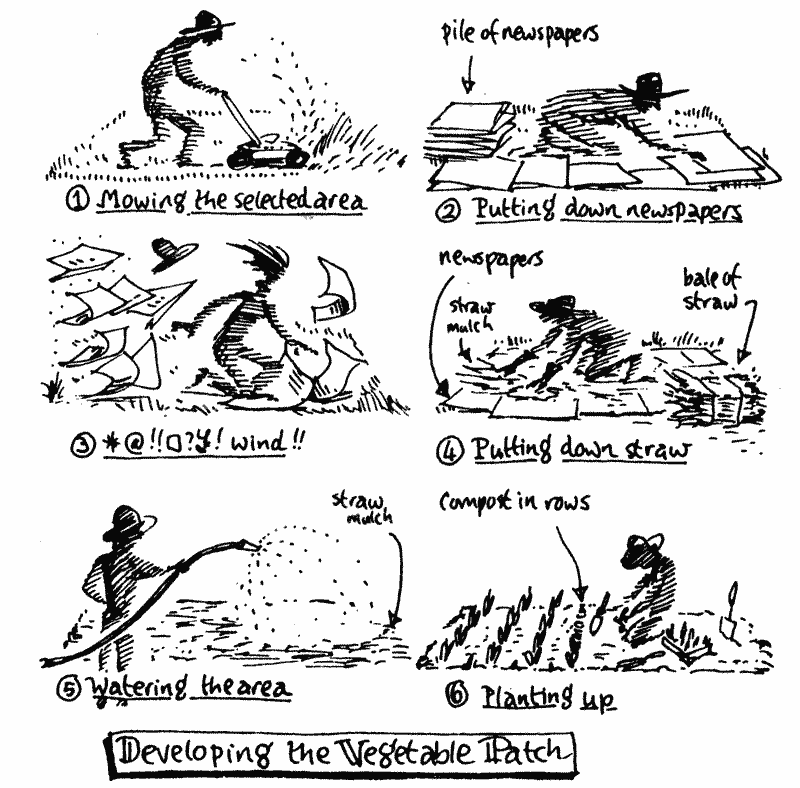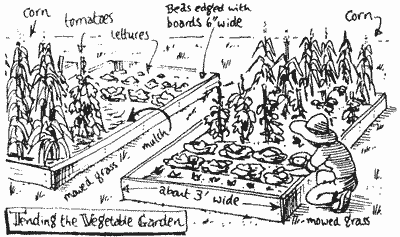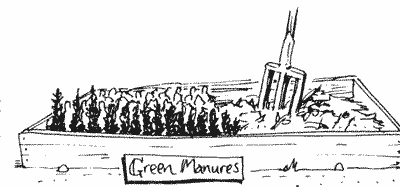
DEVELOPING A VEGIE PATCH IN TROPICAL CLIMATES
Organic Gardening In Tropical Climates is the name of a new book, written by long-time Earth Garden contributor, Liz Sinnamon. The book is published by Earth Garden, and will be available from September, either by mail from Earth Garden, or from bookshops in sub-tropical and tropical parts of Australia. The following article is an extract from Liz's book.
Many people feel reluctant to start a vegetable garden in tropical climates because of the initial heavy digging. However, an easy, simpler alternative is to establish a NO-DIG garden. This method can be used by elderly people and is especially suitable for stony or gravelly areas.
First select the area, as long as the ground is reasonably level. Try to select a place which will make the most use of the sun, particularly in winter. It should preferably face north-east with protection from cold southerly winds.
Now mow the area; sprinkle manure plus lime or dolomite. Then cover the ground with several thicknesses of newspaper. Apply more manure and lime liberally over the newspaper. Then spread over 8 to 15cm of straw (not hay, because this can contain seeds and will quickly turn your new vegie patch back into lawn or weeds!).
Water it daily for seven days. This will settle down the straw and start off the bacterial action in the patch. Worms will also move in and together with microscopic insects, they will release nutrients to feed your plants. To plant up, simply open up holes or lines in the mixture and fill with compost or organic fertiliser mixed with equal parts of soil. Place seedlings or seeds firmly into these areas and water them. The newspaper will slowly break down, killing the grass or weeds underneath and incorporating the remains into the soil.
Lucerne hay can also be used with (or in place of) the straw although it is more expensive.

If you prefer to DIG over your new vegetable garden, do not dig too deeply because most micro-organisms in the soil are contained in the top few inches. Digging too deeply will bury live soil and bring the less fertile soil to the surface.
Grass or weeds on the surface can be removed and this will make the patch easier to dig. Or, after mowing the grass closely, the weeds can simply be incorporated into the soil.
After the initial digging over, fork in lime or dolomite, rock phosphate, animal and bird manures and as much compost as you have available. Rake over the patch to remove any large clods and water it well for a few days. Now you're ready to start planting with either seedlings or seeds.

GARDEN PATHS
In the past, I have experimented with different types of paths in the vegetable garden. Mulched paths have the advantage of being soft to walk on, control weed growth, and need only to be topped up regularly with extra mulch material. However, after trying out several types of garden design, I now find that if the garden beds are edged with hardwood boards or secondhand railway sleepers, the best paths are grassed ones. Although these paths need to be mowed regularly, and the edges trimmed, grass paths have several advantages. After heavy tropical rainfall, the grass absorbs the excess water, leaving the surface reasonably firm and clean.
Mulched paths become soft and slippery after heavy rain, and the earth underneath turn into sticky mud. Walking around the garden, either to collect vegetables or to work, becomes quite treacherous. Mulched paths can also be a problem to maintain, because plentiful supplies of mulch are necessary to keep up a depth of at least 15cm to suppress weeds and grasses effectively.
Garden beds can be approximately one and a half metres wide, so you can work on both sides, and they can be up to ten metres long. The edging boards or sleepers are also very successful in keeping both children and adults from walking across the beds, compacting the soil, and possibly damaging crops.

COVER CROPS AND GREEN MANURES
To prevent or reduce erosion, certain plants can be grown as a cover crop and can be used as green manure. These crops are turned into the soil when they're 75 to 100cm high. This method is perfect for growers who cannot produce enough compost or have difficulty obtaining large quantities of animal manures.
Cover crops also offer protection from plant diseases and insects after seasonal crop rotation. They are excellent for areas of the vegetable garden that are not in use because they blind the soil (reducing the impact of raindrops) and prevent erosion in heavy rainfall areas. Plant roots open up the soil channels, penetrating deep into the earth to improve soil porosity and allowing water to run slowly downwards to prevent soil run-off. These crops can also be used for making compost.
The two types of cover crops grown are legumes and non-legumes. Legumes are plants which can take nitrogen from the air and add it to the soil via nodules on the plants' root systems. The following are plants suitable for cover crops.
LEGUMES
ALFALFA
Alfalfa is a deep-rooted legume grown throughout the world. This crop does well in all but very sandy, clay, acid or poorly-drained soils. It has a high protein and nitrogen content and also contains calcium, magnesium and potassium.
COWPEA
Cowpea is a fine soil builder with powerful roots that will grow through the hardest soils. It is also a quick grower.
FENUGREEK
Fenugreek is a winter legume that needs a fairly rich, loamy soil.
LUPIN
Sour, sandy soils can support lupin. Grow this crop during the winter months.
SWEET CLOVER
This legume will grow in just about any soil if it's reasonably well-supplied with lime. It is fast-growing and can be turned under in the autumn. Plant it in early spring in temperate climates, and early summer in warmer areas.
NON-LEGUMES
BUCKWHEAT
Buckwheat is one of the best choices for rebuilding poor or acid soils. It has an enormous and vigorous root system and is a good bee-attracting plant. You can plant it during spring and summer, and it is possible to grow three crops in a season.
MILLET
Millet grows better on poor soils than many forage or green manure plants. It should be planted thickly for the best results.
OATS
Oats are a winter plant and can be grown on almost any soil provided the climate is cool and moist.
SOYBEANS
Soybeans are planted in the summer and thrive in nearly all kinds of soil including sour soils where other legumes may fail. They can also stand considerable drought.
Always cut your cover crops before they flower or seed, because at this stage the plants contain maximum nutrients.
DATE: September 1993
* * * * * * * * * * * * *
